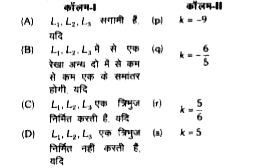सम्मिश्र समतल में, बिन्दु z1,z2,z3 तथा z4 एक समान्तर चतुर्भुज के क्रम से शीर्ष होंगे, यदि और केवल यदि
z1+z2=z2+z3
z1+z3=z2+z4
z1+z2=z3+z4
इनमें से कोई नहीं
The correct Answer is:B
Step by step video, text & image solution for सम्मिश्र समतल में, बिन्दु z_1,z_2,z_3 तथा z_4 एक समान्तर चतुर्भुज के क्रम से शीर्ष होंगे, यदि और केवल यदि by Maths experts to help you in doubts & scoring excellent marks in Class 12 exams.
Topper's Solved these Questions
- BOOK - ERRORLESS HINDICHAPTER - सम्मिश्र संख्यायेंEXERCISE - Solved Multiple Choice Questions (आयोटा की पूर्णांक घातें, सम्मिश्र संख्याओं की बीजगणितीय संक्रियायें तथा समानता)30videos
सम्मिश्र संख्यायें
- BOOK - ERRORLESS HINDICHAPTER - सम्मिश्र संख्यायेंEXERCISE - Solved Multiple Choice Questions (सम्मिश्र संख्याओं का संयुग्मी, मापांक तथा कोणांक)55videos
सम्मिश्र संख्यायें
- BOOK - ERRORLESS HINDICHAPTER - समुच्चय सिद्धान्त तथा सम्बन्ध EXERCISE - JEE Advanced (Reasoning type questions)3videos
समुच्चय सिद्धान्त तथा सम्बन्ध
- BOOK - ERRORLESS HINDICHAPTER - सरल रेखा EXERCISE - JEE ADVANCE (Matrix Match type questions)4videos
सरल रेखा
Similar Questions
यदि (1+i)3(1−i)3−(1−i)3(1+i)3=x+iy
If (1+i)3(1−i)3−(1−i)3(1+i)3=x+iy06:58View Solutionसम्मिश्र संख्याएँ sinx+icos2x तथा cosx−isin2x
x के किस मान के लिये एक दूसरे की संयुग्मी हैं11:09View Solutionमाना R वास्तविक संख्याओं का समुच्चय है
कथन-1 : A={(x,y)∈R×R:y−x एक पूर्णांक है} R पर एक तुल्यता संबंध है |
कथन-2 : B={(x,y)∈R×R:x=αy किसी परिमेय संख्या α के लिए} R पर एक तुल्यता संबंध है |02:06View Solution 02:40View Solution
02:40View SolutionP(z1),Q(z2),R(z3)andS(z4) are four complex numbers representing the vertices of a rhombus taken in order on the complex lane, then which one of the following is/ are correct? z1−z4z2−z3 is purely real ampz1−z4z2−z3=ampz2−z4z3−z4 z1−z3z2−z4 is purely imaginary It is not necessary that |z1−z3|≠|z2−z4|
03:10View SolutionSuppose z_1 + z_2 + z_3 + z_4=0 and |z_1| = |z_2| = |z_3| = |z_4|=1. If z_1, z_2, z_3 ,z_4 are the vertices of a quadrilateral, then the quadrilateral can be a (a) parallelogram (c) rectangle (b) rhombus (d) square
02:41View SolutionThe points, z1,z2,z3,z4, in the complex plane are the vartices of a parallelogram taken in order, if and only if (a)z1+z4=z2+z3 (b)z1+z3=z2+z4 (c)z1+z2=z3+z4 (d) None of these
02:38View SolutionThe points, z1,z2,z3,z4, in the complex plane are the vertices of a parallelogram taken in order, if and only if (a)z1+z4=z2+z3 (b)z1+z3=z2+z4 (c)z1+z2=z3+z4 (d) None of these
03:24View SolutionIf z1,z2,z3,z4 are the affixes of four point in the Argand plane, z is the affix of a point such that |z−z1|=|z−z2|=|z−z3|=|z−z4| , then z1,z2,z3,z4 are
03:47View SolutionIf z1,z2,z3,z4 are the affixes of four point in the Argand plane, z is the affix of a point such that |z−z1|=|z−z2|=|z−z3|=|z−z4| , then prove that z1,z2,z3,z4 are concyclic.
03:52View SolutionIf z1,z2 and z3,z4 are two pairs of conjugate complex numbers then arg(z1z4)+arg(z2z3)=
01:48View SolutionIf Z1,Z2 and Z3,Z4 are two pairs of conjugate complex numbers then arg(Z1Z4)+arg(Z2Z3) equals:
01:48View SolutionIf z1,z2 are conjugate complex numbers and z3,z4 are also conjugate, then arg(z3z2)−arg(z1z4) is equal to
01:28View SolutionIf z1,z2 and z3,z4 are two pairs of conjugate complex numbers, then arg(z1z4)+arg(z2z3) equals
02:23View SolutionIf the fourth roots of unity are z1,z2,z3,z4 then z21+z22+z23+z24 is equal to
02:45View SolutionIf the fourth roots of unity are z1,z2,z3,z4andz21+z22+z23+z24 is equal to :
01:54View Solution

